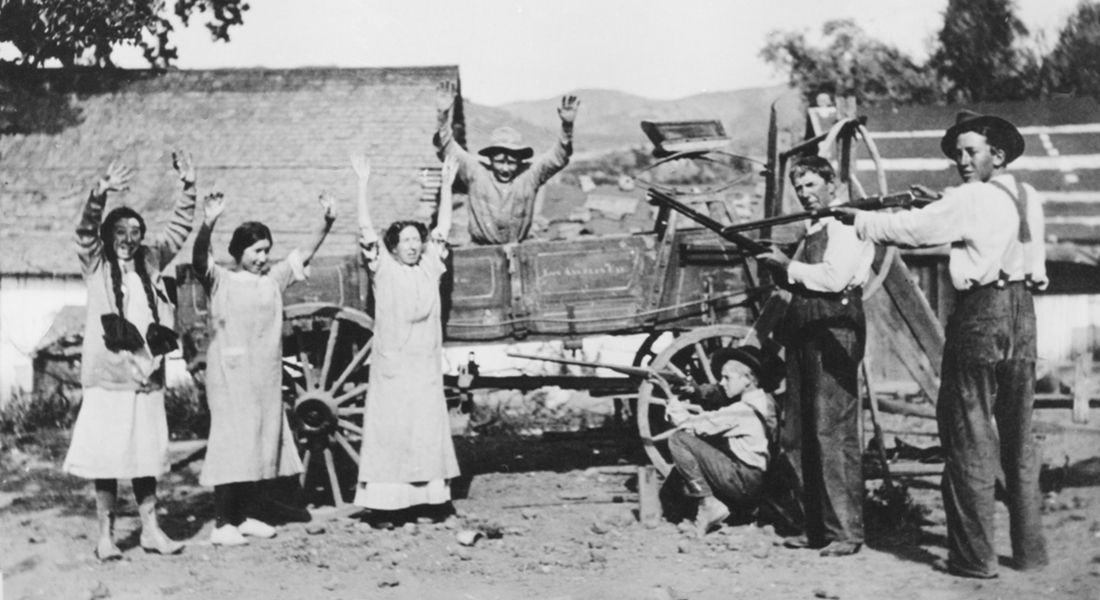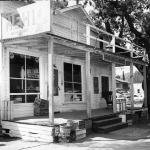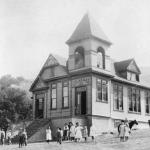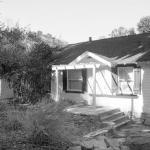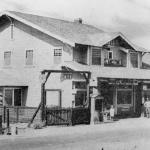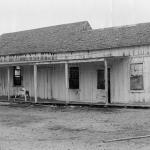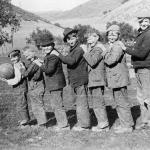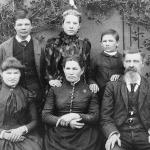The Samuel John Cooper family in a moment of levity
Calabasas: Gourd or Geese?
The origin of Calabasas' name is rooted in different legends. Some believe that the area was named by the Chumash tribe from their word meaning "where the wild geese fly." To this day, Canada geese still fly over the area annually, resting at nearby Pierce College in Woodland Hills. Most locals, however, are more attached to the colorful version of the name's legend of 1824, when a Basque rancher from Oxnard spilled a wagon-load of pumpkins on the road en route to Los Angeles. The following spring, hundreds of pumpkin seeds sprouted alongside the road. The area was named Las Calabasas - the place where the pumpkins fell - after the Spanish word for pumpkin or wild gourd: calabazo.
Indians, Explorers, Squatters, and Bandits
Calabasas was believed to be the border of two friendly tribal nations, the Chumash and Tongva, which lived peacefully among the oaks and sycamores, settling in canyons near streams that provided the necessities of life. Soon after Spanish explorer Juan Portola de Gaspar discovered the region with Father Sierra in 1769, the Indian trails became the footpaths and wagon roads that served the state's mission era. When Mexico took over the territory around 1834, the region's Spanish land grants were given to "Californianos," who established the state's romantic but brief rancho period. Much of the Calabasas area was in Rancho El Escorpión granted to three Native Americans.
In the mid-1800s when Alta California was given to the U.S. by Mexico, the mission era's El Camino Real became one the many stagecoach routes. Calabasas became one of the most legendary frontier towns of the Wild West with its reputation of lawlessness and brawly homesteaders. Women would only enter the region if escorted, and stagecoach drivers avoided Calabasas Junction, hoping to bypass the bloody squatter wars and gun fights. It was the surveyor, not the Sheriff, who eventually came to town and brought back law and order by settling the land disputes.
City History
Crater Camp
In 1914, before serving as the backdrop for Tarzan movies, the Monte Nido area was originally Crater Camp, a recreational destination with a fancy hotel and famed for its healthful environment and beautiful scenery. The name "Monte Nido" (mountain nest) is credited to Al Reithe, an artist who built a showplace home in the area in the 1930's. The home, like the hotel, burned down in a brush fire.
As the county began building more roads, the Monte Nido area became less isolated and attracted year-round residents. In 1937, Los Angeles County purchased one acre of land at Cold Canyon and Piuma roads to erect Patrol Station No. 67. In addition to being a command post for fighting the frequent brush fires, the men who worked at the station also helped maintain the telephone lines and the municipal water facilities. During World War II, they had the task of watching the coast and skies for enemy attacks. Today, the Station is a landmark in an area which still retains its rustic character.
Automotive Era
During the Roaring Twenties, Calabasas became a motoring rest stop as well as a retreat and popular filming location. Homesteaders opened up travel services for the motorists venturing between Los Angeles and points north. The Daic family ran the area's first garage and joining it came antique stores and restaurants along the old El Camino Real, now called Calabasas Road.
Many made Calabasas their destination. Summer retreats filled the local canyons and highlands. Movie stars and studio moguls purchased ranches in the area. Calabasas remained a vacation haven until around 1960, when piped water came to town. Edison purchased Warner Brothers Ranch and developed the residential "all electric home" gated community of Calabasas Park.
Park Moderne
In the early 1920s, Park Moderne, noted as Calabasas' first subdivision, was acquired by two Hollywood businessmen. They bartered some acreage from local homesteader Sam Copper, trading the cost of the land for updating his home with indoor plumbing. The men established an artists' colony, luring Hollywood prop artists out to work on commission in the scenic setting. The area is still home to many fine artists and local residents who now refer to this section of town as "the bird streets," since each street is named after a local bird. Among the first residents in the colony were famed sculptor Jan de Swart, architects Rudolph Schindler and Jock Peters, and artist Andy Anderson, a famous woodcarver whose adobe home still stands today. A steady stream of celebrities and tourists visited him, including Jimmy Durante with his first wife, who often refused to leave. She enjoyed sitting on a favorite rock under a giant oak tree admiring the beautiful view. This inspired Jimmy's famous closing line on his television show, "Goodnight, Mrs. Calabash, wherever you are."
Originally, the colony contained pools, fountains, large totem poles, and three Native American footpaths. The Calabasas Historical Society has preserved the remaining footpath and the Zigzag Moderne fountain with the help of the Los Angeles County Building Department. Running between Bluebird Drive and Blackbird Way, the Bird Path is designated by wooden signs. There is a bronze plaque on the original fountain at the top of the path on Blackbird Way.
L.A. Pet Memorial Park
Since 1928, tucked away in the rolling hills of Calabasas, is a unique and peaceful pet memorial park called S.O.P.H.I.E. (Save Our Pets History In Eternity). Originally called the Los Angeles Pet Cemetery, the park is one of the oldest facilities of its kind on the West Coast. It was founded by Dr. Eugene Jones and his family. They owned and operated the facility for more than forty years. Animal celebrities are among the remembered, including Pete, the loveable dog of the Our Gang comedies, and Hopalong Cassidy's horse, Topper. In 1973, the family graciously donated the cemetery to the Los Angeles SPCA, which eventually gave it to the small group of pet owners who established S.O.P.H.I.E. Inc, a non-profit public benefit corporation, to run the cemetery. The site is dedicated by the State of California and will always be a pet memorial park.
The Calabasas Historical Society helps maintain the collection of artifacts, photos, and research materials relating to the colorful history of a region that attracts the interest of people from around the world. Pamphlets describing walking tours of Park Moderne and Old Town Calabasas are available through the Calabasas Historical Society.
King of Calabasas
In the 1880s, at the height of the Wild West, Basque immigrant Don Miguel Leonis reigned over the western San Fernando Valley from his Calabasas ranch. He was known as the King of Calabasas, acquiring vast land holdings from the family of his Indian bride, Espíritu Chijulla, who owned Rancho El Escorpión. He added to his territory by forcefully acquiring neighboring ranchos and driving off squatters.
In the 1960s, Kay Beachy, who helped preserve much of the San Fernando Valley's historic landmarks, helped save the King's once affluent ranch home from demolition. She purchased the property and additional surrounding landmarks and established a foundation to preserve the area's history. The Leonis Adobe became Los Angeles City Historic Cultural Monument No. l. Surrounding it is Old Town Calabasas, a preserved historic district inviting a look into yesterday. Highlights of the area include the Sagebrush Cantina, a popular restaurant located in the historic Agoure mall, and Calabasas Creek Park, a beautiful replica of a Victorian garden.
Filmmaking
Calabasas' remote and wooded setting and favorable climate made it an ideal location for filmmaking. As early as 1915, Hoot Gibson had shot a Western feature here. Nearby, Monte Nido provided the background for Tarzan features, as the locale easily resembled a lush tropical jungle. Warner Brothers Ranch was located in Calabasas until 1961 and was one of the biggest Hollywood movie lots, at 2,800 acres. Among the films shot at the ranch were "Casablanca","The Santa Fe Trail", and "Sergeant York".
In Malibu Creek State Park, visitors can see the location of Cary Grant's "Mr. Blandings Builds His Dreamhouse" as well as the wildly popular "M*A*S*H" television series, filmed in the hills during the 1970s. Remainders of some of the original sets still can be seen.
Images of America: Calabasas
by Cim Castellon & the Calabasas-Las Virgenes Historical Society
$24.99 Order direct from the author! CimCastellon@gmail.com
$20.00 special discount for members of the CLVHS
All proceeds go towards CLVHS programs and preservation efforts

